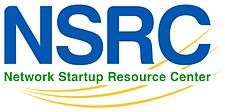Network Startup Resource Center
 | |
| Founded | November 1992 |
|---|---|
| Founders |
John Klensin Randy Bush (scientist) |
| Purpose | Network architecture and education |
| Location | |
Area served | Worldwide |
Key people |
Steve Huter (Director) |
Parent organization | University of Oregon |
| Website |
nsrc |
The Network Startup Resource Center (NSRC)[1] is a nonprofit organization, formed in 1992[2] and based at the University of Oregon. The organization supports deployment of Internet research and education networks in academic institutions and non-governmental organizations throughout the Asia Pacific region, Africa, Latin America and the Caribbean, and the Middle East.[3] NSRC receives major funding and in-kind donations from the National Science Foundation (NSF), Google and Google.org, Cisco, O'Reilly Media, Vint Cerf, the Richard M. Karp Foundation, IDRC, Internet Society (ISOC), and many other institutional and private donors.[4][5]
History
In 1988, Randy Bush and John Klensin began providing pro bono technical support to network engineers in southern Africa. The program was formalized in 1992 with a grant from the U.S. National Science Foundation,[6] and activities expanded to countries in Africa, Asia, and Latin America. NSRC officially moved to the University of Oregon in 1996 and operated as a service of the Computing Center until 2011. The Center is currently administered as a collaboration of the University Libraries and the Office of the Vice-President for Research and Innovation, under the leadership of Steven Huter.[7]
Activities
NSRC provides funding for different Network Operator Groups throughout the world, as well as in-kind equipment, training, and publications necessary to establish Internet connections. As of 2011, in-kind support valued at over $40 million USD had been provided in more than 100 countries.[8] The NSRC's educational programs include workshops, seminars, hands-on technical training and short courses around the world.[9] The goal of these programs is to train local resources and establish an ongoing support system for networking within the region. Work may be done in partnership with other organizations interested in supporting research and education networks in developing regions.[10]
NSRC in Africa
The NSRC has worked for several years with organizations throughout Africa to help expand and stabilize the growing networks on the continent.,,[11][12][13] Initially, the focus had been on teaching best practice around network and systems administration, plus the establishment of solid network monitoring systems in the region. While that network focus continues, additional support is being offered around identity and access management through workshops as requested.[14]
NSRC in Asia
Similar work to the efforts in Africa, the NSRC has coordinated various hardware donations from large vendors to help build national research and education networks in countries across Asia, including Indonesia,[15] Myanmar,[16] Bhutan,[17] Guam,[18] and Vanuatu.[19]
NSRC in Latin America
In Latin America, the NSRC has assisted and trained local support to build national research and education networks in Panama[20] and Guatemala.[21]
References
- ↑ "Network Startup Resource Center". nsrc.org. Retrieved 2016-08-17.
- ↑ "Network Startup Resource Center Founded". Internet Society. October 1992. Retrieved 2016-08-17.
- ↑ Stephenson, Ed (August 1, 2000). "Connecting the Least Connected: Internet Assistance to Developing Countries". O’Reilly Media. Retrieved 2016-08-17.
- ↑ Krakovsky, Marina (March 29, 2011). "With Google's Gift, U. of Oregon Expands International Cyberinfrastructure". Association for Computing Machinery (ACM). Retrieved 2016-11-29.
- ↑ "Google.org Awards Grants Totaling $4.4 Million to Expand Internet Access" (Press release). Philanthropy News Digest. March 1, 2013. Retrieved 2016-08-17.
- ↑ "Award Abstract #9216064 Network Start-up Resource Center". National Science Foundation. August 1, 2000. Retrieved 2016-08-17.
- ↑ Sedmak, Ted (May 20, 2013). "Internet2 President's Leadership Award Winners Support Research and Education at the Margins". Internet2. Retrieved 2016-08-17.
- ↑ Bonamici, Andrew (2010-04-15). "Cultivating Global Cyberinfrastructure for Sharing Digital Resources (EDUCAUSE Review)". Educause.Edu. Retrieved 2016-08-31.
- ↑ "Spreading Knowledge in 2014 – Technical Training with NSRC". Retrieved 2016-08-31.
- ↑ "Empowering network engineers around the world: GÉANT and NSRC renew partnership" (Press release). GÉANT. October 14, 2016. Retrieved 2016-11-29.
- ↑ "SDSC Networking Active Measurement Project Expands to Africa". San Diego Supercomputer Center. 2005-02-11. Retrieved 2016-08-31.
- ↑ Hartnett, David; Semazzi, Fredrick (2005-01-24). The Workshop for Enhancing Collaborative Research on the Environment in Sub-Saharan Africa (PDF). Arlington, VA: National Science Foundation. Retrieved 2016-08-31.
- ↑ "AFNOG Training Programs Help Develop Africa's Internet Infrastructure". 2002-05-20.
- ↑ "WACREN Conference 2016". Dakar Senegal. 2016-03-14. Retrieved 2016-08-31.
- ↑ "2008 APRU CIO CONFERENCE INTERNATIONAL SEMINAR". Universitas Indonesia. Retrieved 2016-08-31.
- ↑ Stone, Richard (2012-11-30). "Raising Up a Fallen Ivory Tower". Science. American Association for the Advancement of Science. 338 (6111): 1140–1142. Retrieved 2016-08-31.
- ↑ "International Partnerships and Knowledge Sharing Help Bhutan Continue on the Path to Advanced Internet Capabilities" (Press release). PR Newswire. April 2015. Retrieved 2016-08-31.
- ↑ "UOG Hosts Regional Campus Network Design Workshop". July 16, 2016. Retrieved 2016-08-31.
- ↑ Webston, Jethro (2016-01-23). "Vanuatu Internet Exchange (VIX): a success story". APNIC.
- ↑ Hahn, Saul (June 1999). "Case Studies on Developments of the Internet in Latin America: Unexpected Results". Bulletin of the Association for Information Science and Technology. 25 (5): 15–17. Retrieved 2016-08-31.
- ↑ Kinzer, Stephen. "Glimmers of Hope in Guatemala". The New York Review of Books (December 5, 2013). Retrieved 2016-08-31.
External links
- Innovative NSRC Team Helps Make Global Networks a Reality. Computing Center News, Computing News ; vol. 12, no. 05 (April/May 1997)
- Cultivating Global Cyberinfrastructure for Sharing Digital Resources. EDUCAUSE Review, vol. 45, no. 2 (March/April 2010): 10-11 Andrew Bonamici, Steven G. Huter, and Dale Smith